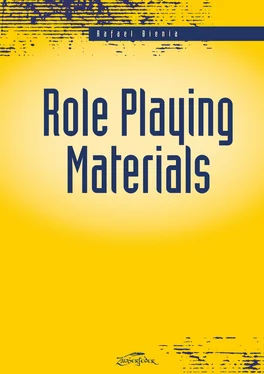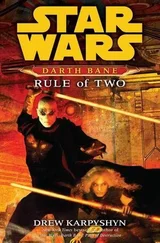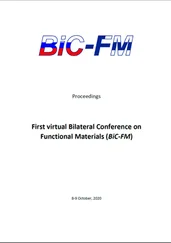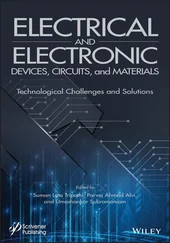Actor-network theory does not claim “that objects do things ‘instead’ of human actors” (Latour, 2005, p. 72). The point is to examine how action emerges as a process in and by heterogeneous relations. This is the reason why I wrote in Chapter 1that it is not enough to solve the ontological problem of what role playing is in general, and how materials collaborate. The inclusion of heterogeneous actors, referring also to non-human actors, addresses the epistemological level of the problem, how to know about role playing. When I use the adjective heterogeneous, I refer to a group of actors that includes different actors, be they human or non-human. The point is not to replace human action with non-human action to understand role playing, but to start with the assumption that anything could be part of the process. To avoid the dichotomy that the word “non-human” evokes, I use the word material.
The group of material actors includes “things, objects” (Latour, 1993, p. 13), “microbes, scallops, rocks, and ships” (Latour, 2005, p. 11), tools and technical artifacts, material structures, transportation devices, texts, and economic goods (Sayes, 2014, p. 136). Material actors include the scale between objects and raw materials. Objects designate elements that are physically constituted, spatially defined and functionally determined. Examples in this book are paper, computers, and clothes. Some of them can be labelled as toys, but the word toy as well as object does not help, because I want to look at raw materials, too. 4Raw materials, such as rocks, water, or metal, lack a predefined functional determination.
When I refer material actors or materials, I have observed action on the physical level and noted a trace of their actions. The pencil, for example, might have a nostalgic meaning for me, because it was a present from my former employer, but when I speak of the pencil as a material actor, I refer to the physical actions of the pencil. The pencil has a certain weight, shape, and durability, because the pencil consists of other material actors that are lined up behind it.
I do not use the word object, because I refer in this study to elements that do not have a defined function. For example, the leather that makes a costume in live action role playing is a component. Using the term material allows me to refer to players themselves as material actors, because players last and consist of matter that could be part of role playing, such as skin, hair, etc. Thus, material actors differ from symbolic, emotional, and similarly abstract actors, not because they are not able to act in these ways, but because the focus is on their physicality.
Material action does not mean that I refer only to action that the laws of causality can express, but physical action that can collaborate with mental processes. Formulating sentences and physical gravity might seem unconnected, but they need no longer be when I think about a sentence and use a pencil that leaves graphite traces on paper. The gain is an alternative understanding of writing as a process that involves material and mental action alike, where the mind/matter dichotomy dissolves because such a dichotomy is not helpful to understand how a graphite core cooperates with the rephrasing of a sentence.
The inclusion of non-humans as potentially equal actors in social processes has been a significant contribution of actor-network theory to studies of the social (Sayes, 2014). The task is to avoid reductionism that words like materials or matter might carry. “To make this possible, we have to free the matters of fact from their reduction by ‘Nature’, exactly as much as we should liberate objects and things from their ‘explanation’ by society” (Latour, 2005, p. 109). To mark that I go beyond the dichotomy between physical matters of fact and socially explicable objects or things, I use the word materials instead of physical actors or objects. Thus, I do not understand actor-network theory “as a sociology ‘extended to non-humans,’” (Latour, 2005, p. 109) because I keep material actors open on a symmetric level until field work shows what clothes, rain, computer hardware, and light account for. Thinking about social processes beyond solely human actions, expands the understanding of role playing as a social process between players to a social process between actors.
The question remains, why actors act in the way they act, when they do not need or “have” an intrinsic essence or a human consciousness. An actor effects social change, but the point is that this capacity to change is not rooted always in a conscious human decision, but emerges from a relation to other actors, which can be other elements that do something. Therefore, I name elements as actors when they do something, when they make a difference in a network.
2.2.2 Network or action at a distance.A network is a gathering, an assemblage, a group of actors that act together. A network gains its stability when actors repeat their actions in a certain manner. When I refer to a role-playing game as a network, I refer to the collaborative work of heterogeneous actors.
Actor-network theory points out a capacity of non-human actors that highlights a spatial and temporal capacity of action. Callon (1991) ascribes the capacity of gathering actors over time and space to non-human actors, better known in the formula “acting at a distance” (Latour, 1987, p. 222). Stability in a network is gained when non-human actors, such as role-playing materials, repeat an action of a temporary gathering. For example, I want to say the word “network.” I do not want to repeat the word myself, so I write the word with a pencil on a piece of paper. The paper bears the graphite marks that show the word “network.” I do not have to say “network” anymore, because the paper repeats the action, saying the word network, of the temporary gathering of me, pencil, and paper.
Thus, materials can “allow an actor that is no longer present to exert a palpable influence” (Sayes, 2014, p. 140). A palpable influence is what makes a difference, although the word “influence” can be misleading when influence is not understood as a process emerging from inter-relational actions. However, the preserving of a relation over space and time is one of the actions that humans desire of non-human actors. What I aim to examine is what happens when materials transport desired actions, or to reformulate the guiding question in this context, how does role playing change over space and time when materials become part of the process?
Actor-network theory as a constructivist paradigm within science, technology, and society studies allows multiple truths instead of one, multiple truths that are constructed by and between actors. Thus, what is studied and how, is a responsibility of the actor-network analyst. It is relevant that an actor-network refers to what is studied, in this case role playing, but it is also a tool to study role playing.
Ontology and epistemology .Network has two meanings according to Latour (2011):
You see that I take the word network not simply to designate things in the world that have the shape of a net […] but mainly to designate a mode of inquiry that learns to list, at the occasion of a trial, the unexpected beings necessary for any entity to exist. A network, in this second meaning of the word, is more like what you record through a Geiger counter that clicks every time a new element, invisible before, has been made visible to the inquirer. (p. 799)
The ontological meaning of network is the network as a collaboration of heterogeneous actors. Until now, I have referred to this meaning when I talked about actors. The epistemological meaning of network is the network of relational processes that become visible when the inquirer recognizes, thinks, and writes them down. The network helps to reveal material actors, because it is an epistemological tool that helps to grow a sense of what is involved in a process. In this sense, researchers like Mol (2010) refuse to apply actor-network theory as a theory, and treat it more like a sensibility to approach a phenomenon while increasing one’s understanding. This twofold understanding of a network is the reason why actor-network theory is apt to answer the two levels of this dissertation’s problem: the ontological, what is role playing, and the epistemological, how to know about role playing.
Читать дальше












